October 2020 LIP of the Month
Tarim large igneous province: definition and petrogenesis
Zhaochong Zhang, Zhiguo Cheng, Dongyang Zhang, Changhong Wang
State Key Laboratory of Geological Processes and Mineral Resources, China University of Geosciences, Beijing, 100083, China
Lead author email: zczhang@cugb.edu.cn
This LIP of the month is based on the following:
Cheng, Z.G., Zhang, Z.C., M. Santosh, Hou, T., & Zhang, D.Y. (2014) Carbonate- and silicate-rich globules in the kimberlitic rocks of northwestern Tarim large igneous province, NW China: Evidence for carbonated mantle source. Journal of Asian Earth Sciences, 95, 114-135.
Cheng, Z. G., Zhang, Z. C., Hou, T., Santosh, M., Zhang, D. Y., & Ke, S. (2015) Petrogenesis of nephelinites from the Tarim Large Igneous Province, NW China: Implications for mantle source characteristics and plume–lithosphere interaction. Lithos, 220-223, 164-178.
Cheng, Z. G., Zhang, Z. C., Hou, T., Santosh, M., Chen, L.l., Ke, S., & Xu L.J. (2017) Decoupling of Mg-C and Sr-Nd-O isotopes traces the role of recycled carbon in magnesiocarbonatites from the Tarim Large Igneous Province. Geochimica et Cosmochimica Acta, 202, 159-178.
Cheng, Z. G., Zhang, Z. C., Xie, Q. H., Hou, T., & Ke, S. (2018a) Subducted slab-plume interaction traced by magnesium isotopes in the northern margin of the Tarim Large Igneous Province. Earth and Planetary Science Letters, 489, 100-110.
Cheng, Z. G., Zhang, Z. C., Aibai, A., Kong, W. L., & Holtz, F. (2018b) The role of magmatic and post-magmatic hydrothermal processes on rare-earth element mineralization: A study of the Bachu carbonatites from the Tarim Large Igneous Province, NW China. Lithos, 314-315, 71-87.
Cheng, Z. G., Zhang, Z. C., Wang, Z. C., Wang, F. Y., Mao, Q., Xu, L. J., Ke, S., Yu, H.M., & Santosh, M. (2020) Petrogenesis of transitional large igneous province: Insights from bimodal volcanic suite in the Tarim large igneous province. Journal of Geophysical Research: Solid Earth, 125, e2019JB018382
Zhang D. Y., Zhang Z. C., Santosh M., Cheng Z. G., Huang H., & Kang J. L. (2013) Perovskite and baddeleyite from kimberlitic intrusions in the Tarim large igneous provincesignalthe onset of an end-Carboniferous mantle plume. Earth and Planetary Science Letters, 361(1), 238-248.
Zhang D. Y., Zhang Z. C., Huang H., Cheng, Z. G., Charlier, B. (2018) Petrogenesis and metallogenesis of the Wajilitag and Puchang Fe-Ti oxide-rich intrusive complexes, northwestern Tarim Large Igneous Province. Lithos, 304-307, 412-435.
Zhang D.Y., Zhang Z.C., Mao J., Huang H., & Cheng Z.G. (2016) Zircon U–Pb ages and Hf–O isotopic signatures of the Wajilitag and Puchang Fe–Ti oxide–bearing intrusive complexes: Constraints on their source characteristics and temporal–spatial evolution of the Tarim large igneous province. Gondwana Research, 37, 71-85.
Wang, C. H., Zhang, Z. C., Xie, Q. H., Cheng, Z. G., Kong, W. L., Liu, B. X., Santosh, M., & Jin, S. K. (2020) Olivine from aillikites in the Tarim large igneous province as a window into mantle metasomatism and multi-stage magma evolution. American Mineralogist, DOI: https://doi.org/10.2138/am-2020-7521.
Introduction
In terms of the proportion of felsic rocks, large igneous provinces (LIPs) have been divided into mafic and silicic types with the latter generally referred to as a SLIP (Bryan & Ernst, 2008; Ernst, 2014). They represent two end members in the LIP clan, whereas transitional LIPs with similar proportions of mafic and felsic rocks are largely missing (Bryan et al. 2002). The mafic LIP that is dominated by mafic rocks with minor felsic rocks (<10 %) is generally correlated to mantle plume (Bryan, 2007; Bryan & Ernst, 2008; Bryan et al., 2002; Shellnutt et al., 2012), while the origin of the voluminous felsic rocks in silicic LIPs is still debated. It has been suggested that the large volumes of felsic magma could be produced by partial melting of a highly fertile hydrous crust by the underplating basaltic magma, the underplate portion of a LIP (e.g. Bryan et al., 2002; Ernst, 2014). However, cases in which a mafic LIP shows a close temporal and spatial relationship with a silicic LIP (SLIP) have not been confirmed, and hence this linkage still lacks crucial geological evidence.
Located in northwestern China, the Tarim large igneous province (T-LIP) is considered as the second major LIP after the Emeishan LIP in China (Fig. 1a). Although the region is largely covered by the desert, drill-hole data and seismic profiles have revealed a large area of felsic volcanic rocks (~48,000 km2) and approximately 265,000 km2 of basalts in the T-LIP (Fig. 1b; Liu et al., 2014; Pan et al., 2013; Xu et al., 2014; Yang et al., 2014). Due to the high proportion of the felsic rocks, T-LIP was recently proposed as a transitional LIP between the mafic and silicic LIP types (Cheng et al., 2020). In addition, T-LIP also displays several special characteristics such as complex lithology, long duration and alkaline and iron-rich affinity of the dominated lithology that are distinct from other typical mafic LIPs. The scientific issue is the genesis of T-LIP having these specific features. In the past decade, our group systematically conducted geochronological, petrologic, geochemical and isotopic research (especially non-traditional Mg isotopes) on various igneous rocks. In this contribution, we provide a summary of our recent publications on the T-LIP with a view to understand the formation of this special LIP and then build a close linkage between these rocks and deep geodynamic processes.
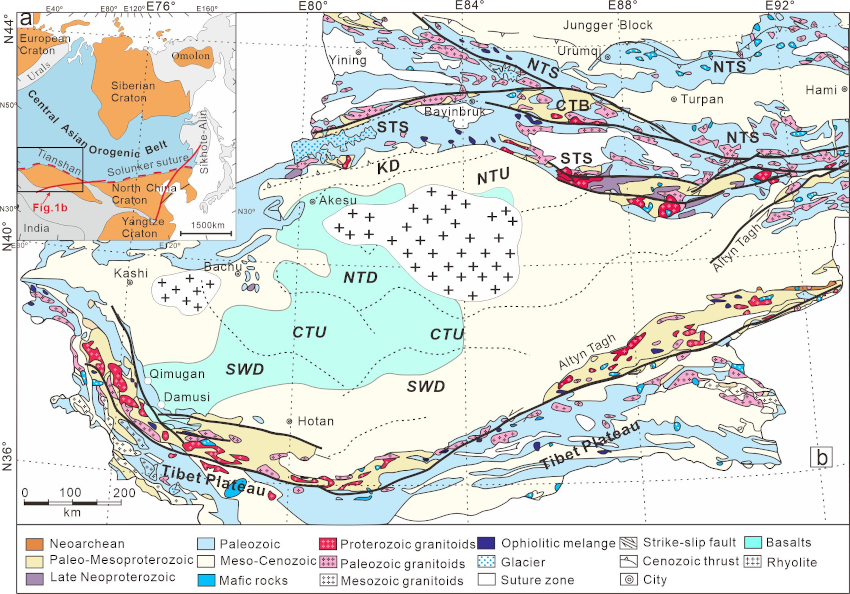
Figure 1. (a) Map of the Chinese continental collage showing the distribution of the T-LIP; (b) Sketch geological map of T-LIP. Abbreviation: KD, Kuche Depression; NTU, Northern Tarim uplift; NTD, Northern Tarim Depression; CTU, Central Tarim Uplift; SWD, Southwestern Depression; NTS, North Tianshan; STS, South Tianshan; CTB, Central Tianshan Block (Cheng et al., 2020).
Tarim large igneous province
Tarim basin in northwestern China is surrounded by Tianshan Mountain to the north and Kunlun Mountain to the South (Fig. 1a). The Tarim basin has a Late Archean to Proterozoic basement overlain by a thick Phanerozoic cover. Voluminous Early Permian basalts, mafic-ultramafic layered intrusions and mafic dykes are widespread in the Tarim basin and constitute the T-LIP (Xu et al., 2014; Yang et al., 2014). Compared with other LIPs, the T-LIP has four specific characteristics: 1) Complex lithology: in addition to flood basalts, mafic-ultramafic layered intrusions, mafic dykes, rhyolite and picrite, which are common in LIPs, there are also some special rocks that are only associated with some LIPs, such as aillikite (which was previously regarded as kimberlitic rocks in Zhang et al. (2013) and Cheng et al. (2014, 2018a), but recently was identified as aillikite based on the detailed petrologic study by our group (Wang et al., 2020)), nephelinite (Cheng et al., 2015), carbonatite (Cheng et al., 2017, 2018b), sodic lamprophyre, nepheline syenite and diverse dykes in the mafic-felsic composition. The link between carbonatites and kimberlites and some LIPs are discussed in Ernst & Bell (2010) and Ernst et al. (2018). 2) While many LIP, but not all, are emplaced in a very short time of a few million years or less (Kasbohm et al., 2021; Ernst, 2014), the T-LIP has a longer duration of about 30 Ma, and consists of four pulses: a) 300 Ma aillikite, 290-285 Ma bimodal volcanic rocks including the flood basalt and rhyolite, b) 285.9-275 Ma mafic-ultramafic layered intrusions and c) ~270 Ma later various dykes (including mafic and felsic dykes and carbonatite dykes) and d) nephelinite (~268 Ma) (Zhang et al., 2013, 2016; Cheng et al., 2014; Xu et al., 2014, 2017; Shangguan et al., 2016). The flood basalts are the dominate rocks in T-LIP by volume. 3) The dominant lithology is characterized by alkaline and iron-rich affinity: According to published data from basalts and picrites, most of compositions plot in the alkaline fields and show high TFeO contents (>12.5 % and up to 18.7 wt.%; e.g., Zhou et al., 2009; Tian et al., 2010). 4) There is also a high proportion of felsic rocks: As noted above, the felsic rocks in T-LIP could occupy an area of 48,000 km2 (up to 20% of the total volume) and indicate that the T-LIP could be termed as a transitional LIP between mafic and silicic LIPs (Cheng et al., 2020).
Petrogenesis of the mafic rocks
Geochemical compositions show that the basalts are characterized by enrichment in large ion lithophile elements and light rare earth elements, which are similar to OIBs. Furthermore, two categories of flood basalts were identified in the T-LIP: Group 1 basalts that are the dominant type display lithospheric mantle signatures with weak negative Nb-Ta anomalies, high (87Sr/86Sr)i and low 143Nd/143Nd ratios; Group 2 basalts from NTU show positive Nb-Ta anomalies, lower (87Sr/86Sr)i and higher 143Nd/143Nd ratios, suggesting a possible asthenospheric origin with potential interaction with the lithosphere (Yu et al., 2017).
Compared to the early flood basalts, the later mafic-ultramafic layered intrusions exhibit positive Nb-Ta anomalies and depleted Sr-Nd-Hf isotopic compositions, and were hence suggested to be the product of the mantle plume-derived magmas by fractional crystallization (Xu et al., 2014; Wei et al., 2014). However, zircon SIMS oxygen isotopes measured in situ are still more enriched than those of the depleted mantle, indicating a lithospheric mantle source for the mafic-ultramafic layered intrusions (Zhang et al., 2016, 2018). Based on the relationship between the Sr-Nd-O-Mg isotopes and the partial melting degrees, Cheng et al. (2018a) proposed that both the Group-1 basalts and mafic-ultramafic layered intrusions should have originated from the lithospheric mantle, while the enriched components in the mantle sources were waning over time from basalts (290-285 Ma) through layered intrusions (285.9-275 Ma) to the later mafic dykes (~270 Ma) (Fig. 2).
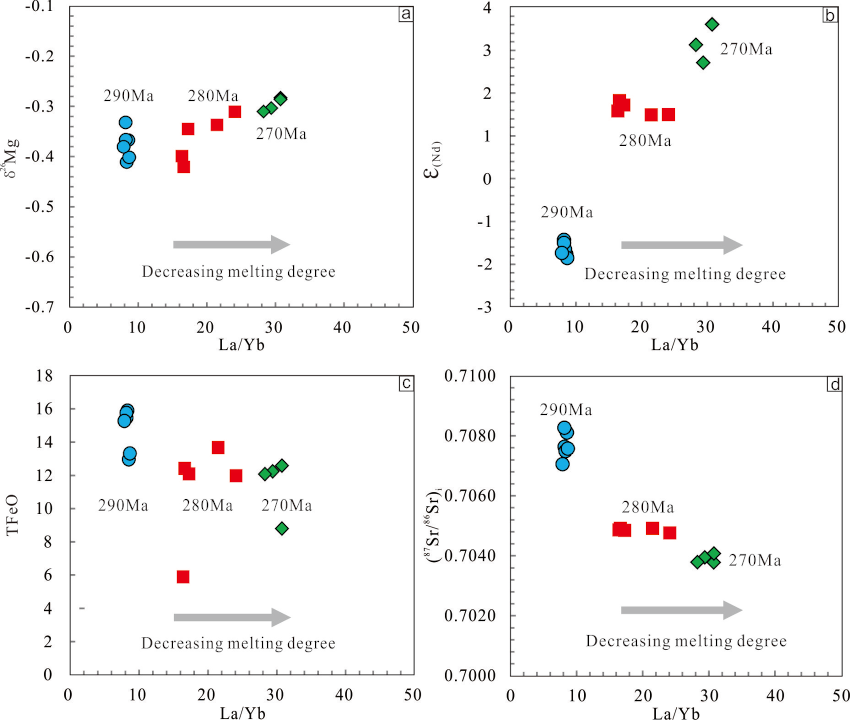
Figure 2. Diagrams showing the relationships between Sr-Nd-Ο-Mg isotopic compositions, and the partial melting degrees, together with the variation of time. The symbols are the same as Fig. 3 (Cheng et al., 2018a).
Notably, the basalts (including the picrite) in T-LIP are typically characterized by high alkali and iron contents (most of TFeO contents >12.5 wt.% and up to 18.7 wt.%) and hence could be termed ferropicrite/ferrobasalts (Cheng et al., 2018a). On the other hand, based on the reconstruction, the primitive magma of the Wajilitage and Puchang mafic-ultramafic intrusions are suggested to be ferropicrite in composition (Zhang et al., 2016, 2018). In addition, the iron-rich feature is also displayed by the aillikite and nephelinite (Cheng et al., 2015). The generation of the iron-rich rocks is suggested to be related to the involvement of recycled pyroxenite/eclogite components in the mantle sources (Zhang et al., 2016, 2018; Cheng et al., 2018a). Systematic Mg isotopic studies on the major rocks of T-LIP (including basalts, mafic-ultramafic layered intrusions, mafic dykes, aillikite, nephelinite and carbonatite) revealed lighter Mg isotopic compositions (<0.25‰) than the normal mantle (Fig. 3), indicating the contribution of ancient recycled sedimentary carbonate rocks in their mantle sources (Cheng et al., 2015, 2017, 2018a). The carbonated mantle sources and the involved pyroxenite/eclogite components are considered to be the main controlling factors for the generation of the alkaline and iron-rich mafic rocks (Fig. 4a). Furthermore, according to the Sr-Mg isotopic modeling, two distinct mantle domains are recognized for T-LIP: 1) a lithospheric mantle source for the basalts and mafic-ultramafic layered intrusions which were modified by the calcite/dolomite and eclogite-derived high-Si melts, as evidenced by enriched Sr-Nd-O and light Mg isotopic compositions; 2) a plume source for carbonatite, nephelinite and aillikite which were related to the magnesite or periclase/perovskite involvement as reflected by the depleted Sr-Nd-O and extremely light Mg isotopes (Fig. 4b; Cheng et al., 2018a).
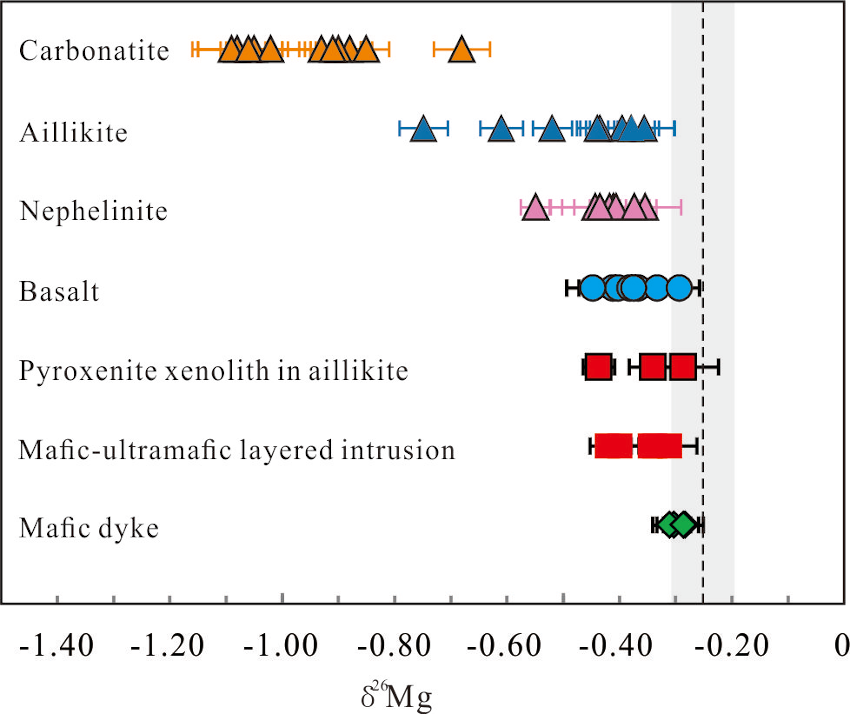
Figure 3. The distribution of Mg isotopic compositions of lithology in the T-LIP (Cheng et al., 2018a). Note: the kimberlitic rocks should be aillikite based on our new petrologic study (Wang et al., 2020).
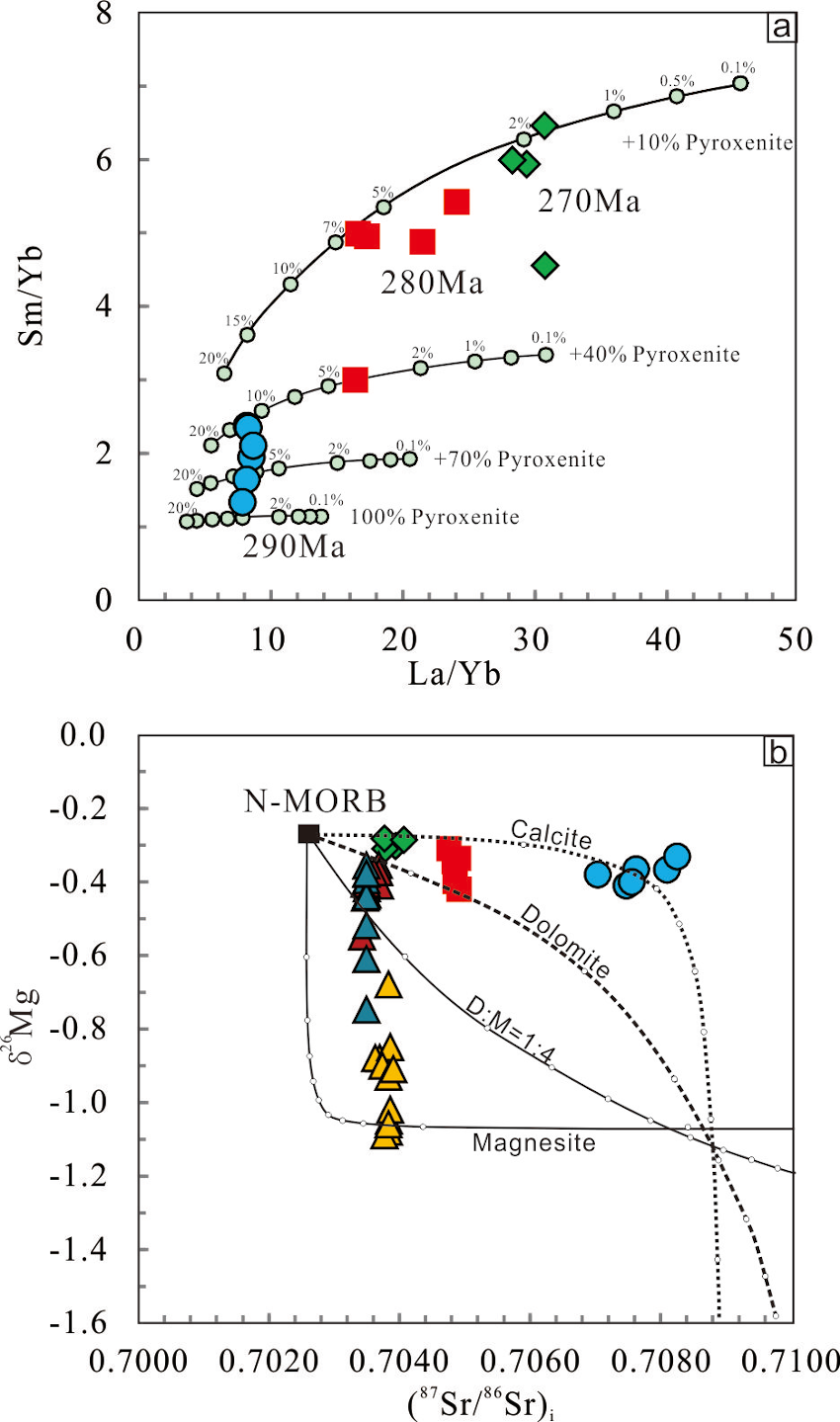
Figure 4. (a) Sm/Yb vs. La/Yb diagram showing the partial melting degrees of the T-LIP lithologies. (b) Mg and Sr isotope exchange model between N-MORB and calcite, dolomite and magnesite (Cheng et al., 2018a). The symbols are the same as Fig. 3.
Petrogenesis of the felsic rocks
The geochemical studies show that felsic rocks in the T-LIP are commonly characterized by two distinct groups, i.e. one crustal-like group with negative Nb-Ta anomalies, crustal La/Nb, Ce/Pb and Nb/U ratios and radioactive Sr-Nd-Hf isotopic compositions, and the other one is a mantle-like group with positive Nb-Ta anomalies, chondritic La/Nb and Nb/U ratios and depleted Sr-Nd-Hf isotopic compositions, which were suggested to be related to crustal anatexis and fractional crystallization coupled with crustal assimilation, respectively (Liu et al., 2014; Tian et al., 2010; Cheng et al., 2020). Cheng et al. (2020) further noted that the crustal-like group has εNd values that are much lower than those of the Tarim basement, indicating the involvement of mantle-derived magma, and hence they proposed a MASH model to explain the formation of the crustal-like felsic rocks (Fig. 5). It is suggested that a key factor to yield the large volumes of felsic magma is the prior formation of a highly fertile, hydrous crust (Bryan et al., 2002). However, the high-water contents in felsic suites associated with LIPs still lack evidence. In order to evaluate the role of hydrous crust in the formation of felsic rocks in LIPs, we used the updated plagioclase-liquid hydrometer proposed by Waters & Lange (2015) to estimate the water contents for the felsic rocks in T-LIP and also some other mafic LIPs (NAIP, Madagascar, Columbia River, Paraná-Etendeka and Karoo) and a silicic LIP (Sierra Madre Occidental) to make a comparison. The results show that the H2O contents of felsic rocks from silicic LIP are significantly higher than those of the mafic LIPs, while the felsic rocks in mafic LIPs could display both low and high H2O contents (Fig. 6a; Cheng et al., 2020). In addition, the water contents of the felsic rocks in mafic LIPs display a positive relationship with the (87Sr/86Sr)i values, indicating the contribution of the hydrous crust (Fig. 6b).
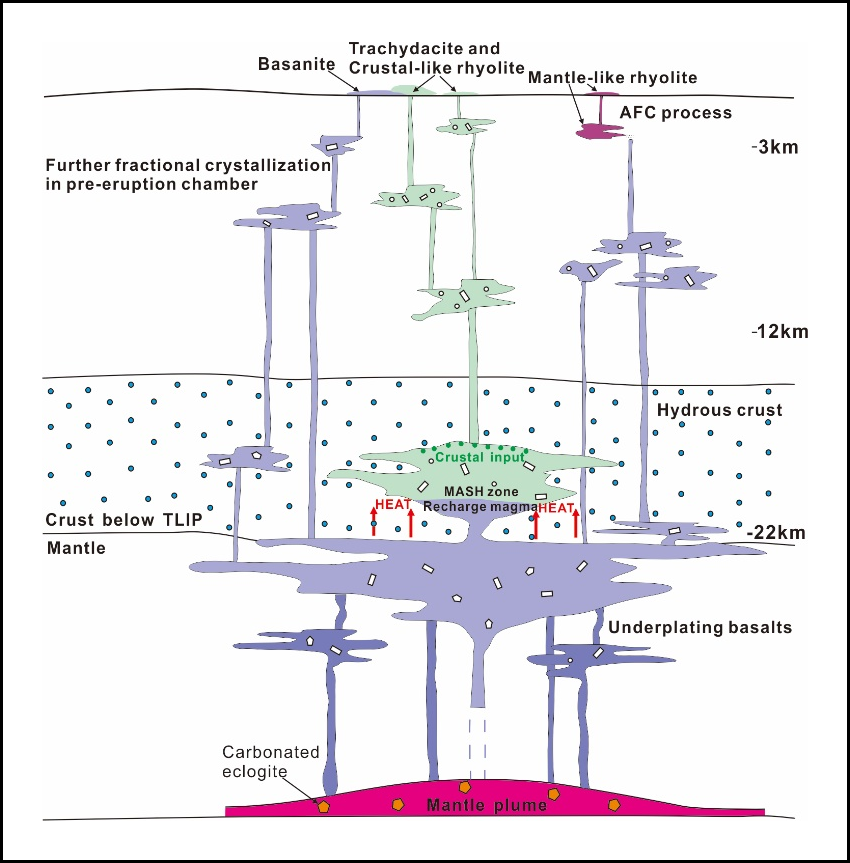
Figure 5. Schematic model for the generation of the crustal-like and mantle-like felsic rocks, and their genetic relationship with the basalts. With the impingement of the mantle plume, decompression melting is triggered, resulting in the formation of basaltic magmas. The MASH process is invoked to explain the generation of the voluminous crustal-like felsic rocks, and the AFC process was involved, which would account for the formation of the mantle-like features of the rhyolite (Cheng et al., 2020).
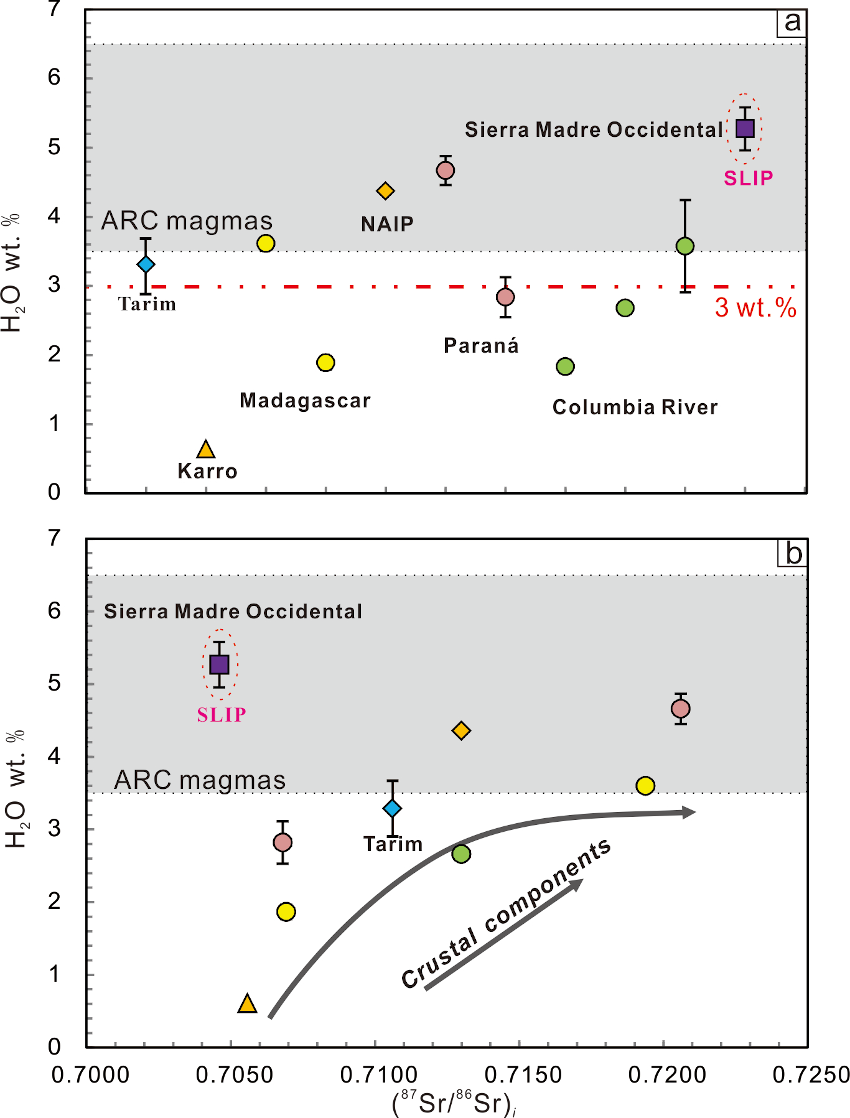
Figure 6. (a) Melt H2O contents (wt.%) calculated by the hygrometer proposed by Waters & Lange (2015) of the Tarim and also some other mafic LIPs (NAIP, Madagascar, Columbia River, Paraná-Etendeka LIP and Karoo). (b) The plot of the melt H2O contents vs (87Sr/86Sr)i shows a positive trend (Cheng et al., 2020).
Subducted slabs-lithosphere-mantle plume interaction model for T-LIP
Based on the discussion above, two distinct mantle domains were recognized in T-LIP, which were derived from different metasomatized processes (Fig. 7). The mantle sources for the basalts and mafic-ultramafic layered intrusions were proposed to be modified by the calcite/dolomite and eclogite-derived high-Si melts, while the sources for the carbonatite, nephelinite and aillikite units were related to the magnesite or periclase/perovskite metasomatism. With the progressive partial melting of the mantle, the components with enriched Sr-Nd-O isotopes and light Mg isotopes were waning over time. These observations lead us propose a subducted slab-lithosphere-mantle plume interaction model to explain the generation of T-LIP (Fig. 7).
In summary, the carbonated mantle sources and the involved pyroxenite/eclogite components are responsible for the alkaline and iron-rich affinity of the dominant rocks. Different degrees of partial melting of the distinct mantle sources could lead to the generation of the complex lithology of the T-LIP. On the other hand, the recycled carbonated eclogite in the mantle plume could also account for the long duration, which is inferred from the numerical modeling by Cordery et al. (1997) and Lin & Kekin (2005) that eclogite entrained in plumes could contribute to multiple episodes of LIPs and extend the plume-related melting to a much longer period of up to ~50 Ma. On the other hand, while the MASH and AFC model could explain the crustal-like and mantle-like felsic rocks, our study revealed hydrous crustal components could significantly contribute to producing the voluminous felsic rocks in LIPs.
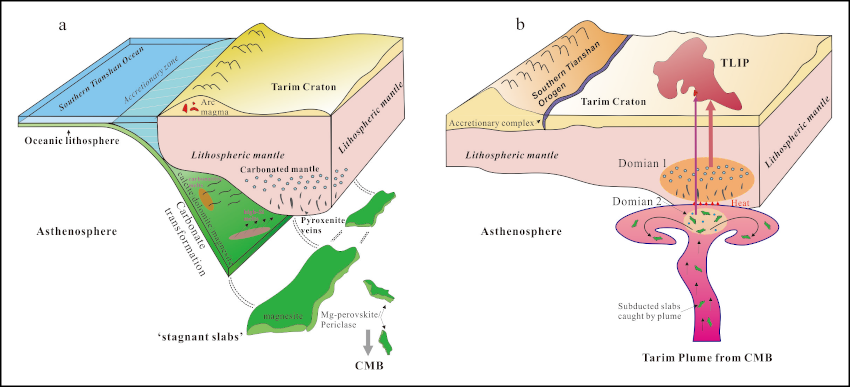
Figure 7. A proposed genetic model of subducted slab-lithosphere-mantle plume interaction for the T-LIP (Cheng et al., 2018a). a). In the Neoproterozoic and early-middle Paleozoic time, the southward subduction delivered the sedimentary carbonate rocks and oceanic crust into the mantle. Calcite and dolomite were melted in the early stages of the subduction and metasomatized the overlying lithospheric mantle and formed the carbonated peridotite (domain 1). Under a pressure of >4.5 GPa, calcite and dolomite are changed to magnesite, which is refractory over a wide range of P-T condition (2300 K at 15 GPa; Katsura and Ito, 1990). Then, high-Si melts could be derived from partial melting of eclogite, and reacted with the overlying lithospheric mantle and generated the ‘iron-rich streaks’ (Domain 1); b). With the increasing depth, the carbonates would be expected to transform to the periclase and perovskite (2700K and 12-84 Gpa; Solopova et al., 2015). The submerged slabs with magnesite, periclase and perovskite were caught by the upwelling plume during the ascent, and then generated a heterogeneous mantle plume (Domain 2), with geochemical and isotopic compositions distinct from the Domain 1.
Acknowledgement
The authors greatly appreciate R.E. Ernst for encouragement and the invitation to write this article for largeigneousprovinces.org.
The research was carried out in the China University of Geosciences, Beijing, with the financial support of National Natural Science Foundation of China (41472060, 41772057 and 41702064), China Postdoctoral Science Foundation funded project (2017M610104) and 111 Project (B07011).
References:
Bryan, S. E. (2007). Silicic Large Igneous Provinces. Episodes, 30, 20-31.
Bryan, S. E., & Ernst, R. E. (2008). Revised definition of Large Igneous Provinces (LIPs). Earth-Science Reviews, 86, 175-202.
Bryan, S. E., Riley, T. R., Jerram, D. A., Stephens, C. J., & Leat, P. T. (2002). Silicic volcanism: An undervalued component of large igneous provinces and volcanic rifted margins. Geological Society of America Special Paper, 362, 97-118.
Cheng, Z.G., Zhang, Z.C., M. Santosh, Hou, T., & Zhang, D.Y. (2014) Carbonate- and silicate-rich globules in the kimberlitic rocks of northwestern Tarim large igneous province, NW China: Evidence for carbonated mantle source. Journal of Asian Earth Sciences, 95, 114-135.
Cheng, Z. G., Zhang, Z. C., Hou, T., Santosh, M., Zhang, D. Y., & Ke, S. (2015) Petrogenesis of nephelinites from the Tarim Large Igneous Province, NW China: Implications for mantle source characteristics and plume–lithosphere interaction. Lithos, 220-223, 164-178.
Cheng, Z. G., Zhang, Z. C., Hou, T., Santosh, M., Chen, L.l., Ke, S., & Xu L.J. (2017) Decoupling of Mg-C and Sr-Nd-O isotopes traces the role of recycled carbon in magnesiocarbonatites from the Tarim Large Igneous Province. Geochimica et Cosmochimica Acta, 202:159-178.
Cheng, Z. G., Zhang, Z. C., Xie, Q. H., Hou, T., & Ke, S. (2018a) Subducted slab-plume interaction traced by magnesium isotopes in the northern margin of the Tarim Large Igneous Province. Earth and Planetary Science Letters, 489, 100-110.
Cheng, Z. G., Zhang, Z. C., Aibai, A., Kong, W. L., & Holtz, F. (2018b) The role of magmatic and post-magmatic hydrothermal processes on rare-earth element mineralization: A study of the Bachu carbonatites from the Tarim Large Igneous Province, NW China. Lithos, 314-315, 71-87.
Cheng, Z. G., Zhang, Z. C., Wang, Z. C., Wang, F. Y., Mao, Q., Xu, L. J., Ke, S., Yu, H.M., & Santosh, M. (2020) Petrogenesis of transitional large igneous province: Insights from bimodal volcanic suite in the Tarim large igneous province. Journal of Geophysical Research: Solid Earth, 125, e2019JB018382
Cordery, M. J., Davies, G. F., & Campbell, I. H. (1997) Genesis of flood basalts from eclogite-bearing mantle plumes. Journal of Geophysical Research, 102 (B9), 20179-20197.
Ernst, R. E. (2014) Large Igneous Provinces. Cambridge University Press, p 653.
Ernst, R.E., & Bell, K. (2010). Large Igneous Provinces (LIPs) and Carbonatites. Mineralogy and Petrology, 98, 55-76.
Ernst, R.E., Davies, D.R., Jowitt, S.M., Campbell, I.H. (2018). When do mantle plumes destroy diamonds? Earth and Planetary Science Letters, 502 (15), 244-252
Kasbohm, J., Schoene, B., Burgess, S. (2021). Radiometric Constraints on the Timing, Tempo, and Effects of Large Igneous Province Emplacement. In: Ernst, R.E., Dickson, A.J., Bekker, A. (eds.) Large Igneous Provinces: A Driver of Global Environmental and Biotic Changes. AGU Geophysical Monograph 255 (in press).
Katsura, T., & Ito, E. (1990) Melting and subsolidus relations in the MgSiO3-MgCO3 system at high pressures: implications to evolution of the Earth’s atmosphere. Earth and Planetary Science Letters, 99, 110-117.
Li, H. Y., Huang, X. L., Li, W. X., Cao, J., He, P. L., & Xu, Y. G. (2013) Age and geochemistry of the Early Permian basalts from Qimugan in the southwestern Tarim basin. Acta Petrologica Sinica, 29(10), 3353-3368.
Lin, S. C., & van Keken, P. E. (2005) Multiple volcanic episodes of flood basalts caused by thermochemical mantle plumes. Nature, 436, 14, 250-252.
Liu, H. Q., Xu, Y. G., Tian, W., Zhong, Y. T., Mundil, R., Li, X. H., Yang, Y. H., Luo, Z. Y., & Shangguan, S. M. (2014). Origin of two types of rhyolites from Tarim Large Igneous Province: consequences of plume incubation and melting. Lithos, 204, 59-72.
Pan, Y., Pan, M., Tian, W., Wang, Z. X., Guan, P., Liu, X., & Pan, W. Q. (2013) Redefined Distribution of the Permian Basalt in the Central Tarim Area: A New Approach Based on Down Hole Logging Data Explanation. Acta Geologica Sinica, 87(10), 1542-1550. (In Chinese with English abstract)
Shangguan, S. M., Peate, I. U., Tian, W., & Xu, Y. G. (2016) Re-evaluating the geochronology of the Permian Tarim magmatic province: implications for temporal evolution of magmatism. Journal of the Geological Society, 173, 228-239.
Shellnutt, J. G., Denyszyn, S. W., & Mundil, R. (2012) Precise age determination of mafic and felsic intrusive rocks from the Permian Emeishan large igneous province (SW China). Gondwana Research, 22, 118-126.
Solopova, N. A., Dubrovinsky, L., & Spivak, A. V. (2015) Melting and decomposition of MgCO3 at pressures up to 84 GPa. Physics and Chemistry of Minerals, 42, 73-81.
Tian, W., Campbell, I. H., Allen, C. M., Guan, P., Pan, W. Q., Chen, M. M., Yu, H. J., & Zhu, W. P. (2010) The Tarim picrite–basalt–rhyolite suite, a Permian flood basalt from northwest China with contrasting rhyolites produced by fractional crystallization and anatexis. Contribution to Mineralogy and Petrology, 160, 407-425.
Wang, C. H., Zhang, Z. C., Xie, Q. H., Cheng, Z. G., Kong, W. L., Liu, B. X., Santosh, M., & Jin, S. K. (2020) Olivine from aillikites in the Tarim large igneous province as a window into mantle metasomatism and multi-stage magma evolution. American Mineralogist, DOI: https://doi.org/10.2138/am-2020-7521.
Waters, L. E., & Lange, R. A. (2015) An updated calibration of the plagioclase-liquid hygrometer-thermometer applicable to basalts through rhyolites. American Mineralogist, 100, 2172-2184.
Wei X., Xu Y. G., Fen, Y. X., & Zhao, J. X. (2014) Plume-lithosphere interaction in the generation of the Tarim large igneous province, NW China: Geochronological and geochemical constraints. American Journal of Science, 314, 314-356.
Xu, Y. G., Wei, X., Luo, Z. Y., Liu, H. Q., & Gao, J. (2014) The Early Permian Tarim large igneous province: Main characteristics and a plume incubation model. Lithos, 204, 20-35.
Xu, Y. G., Zhong, Y. T., Wei, X., Chen, J., Liu, H. Q., Xie, W., Luo, Z. Y., Li, H. Y., He, B., Huang, X. L., Wang, Y., & Chen, Y. (2017) Permian Mantle Plumes and Earth's Surface System Evolution. Acta Metallurgica Sinica, 2017, 36(3), 359-373. (in Chinese with English abstract)
Yang, S. F., Chen, H. L., Li, Z. L., Li, Y. Q., Yu, X., Li, D. X., & Meng, L. F. (2014). Early Permian Tarim Large Igneous Province in northwest China. Science China: Earth Sciences, 56, 2015–2026.
Yu, X., Yang, S. F., Chen, H. L., Li, Z. L., & Li, Y. Q. (2017). Petrogenetic model of the Permian Tarim Large Igneous Province. Science China: Earth Sciences, 60(10), 1805-1816.
Zhang, C. L., Xu, Y. G., Li, Z. X., Wang, H. Y., & Ye, H. M. (2010) Diverse Permian magmatism in the Tarim Block, NW China: genetically linked to the Permian Tarim mantle plume? Lithos 119, 537-552.
Zhang, D. Y., Zhang, Z. C., Santosh, M., Cheng, Z. G., Huang, H., & Kang, J. L. (2013) Perovskite and baddeleyite from kimberlitic intrusions in the Tarim large igneous provincesignalthe onset of an end-Carboniferous mantle plume. Earth and Planetary Science Letters, 361(1), 238-248.
Zhang D. Y., Zhang Z. C., Huang H., Cheng, Z. G., & Charlier, B. (2018) Petrogenesis and metallogenesis of the Wajilitag and Puchang Fe-Ti oxide-rich intrusive complexes, northwestern Tarim Large Igneous Province. Lithos, 304-307, 412-435.
Zhang, D. Y., Zhang, Z. C., Mao J., Huang H., & Cheng, Z. G. (2016) Zircon U–Pb ages and Hf–O isotopic signatures of the Wajilitag and Puchang Fe–Ti oxide–bearing intrusive complexes: Constraints on their source characteristics and temporal–spatial evolution of the Tarim large igneous province. Gondwana Research, 37, 71-85.
Zhou, M. F., Zhao, J. H., Jiang, C. Y., Gao, J. F., Wang, W., & Yang, S. H. (2009) OIB-like, heterogeneous mantle sources of Permian basaltic magmatism in the western Tarim Basin, NW China: Implications for a possible Permian large igneous province. Lithos, 113, 583-594.
